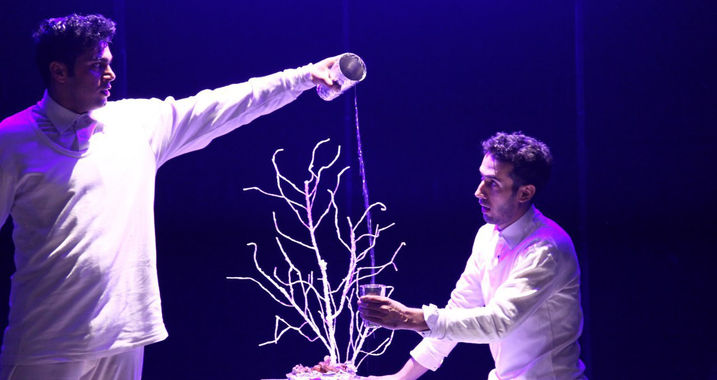
Performed at the International University Theatre Festival and “Tajrobe” Theatre Festival, also running for two weeks at Nazer Zadeh Hall, the University of Tehran.
Public Game
University of Tehran 2016
Concept and Directing: Nazanin Bahram
Performers: Omid Mashhadi, Peyman Madhani


The whole idea began with a picture. The picture of two men in an untidy kitchen, sitting on worn and shabby chairs, wearing strange and bizarre masks, holding their teacups, and staring at the photographer’s camera. As if they are being controlled by a creator who watches them from the outside. This was a photo taken by Daniel Josefsohn. Looking at this photo, we have decided to write a story for the characters inside the frame of Mr. Josephson’s photo and to translate it into a performance. Both phases of Writing the text and rehearsing with actors advanced simultaneously.
The ideas for shaping the plot were recorded in the rehearsal period after having discussions with the actors, and through accidental collages, the dialogues were shaped. This form of writing was inspired by the writing method of the American novelist, William S. Burroughs: the cut-up technique, a writing collage. The purpose of experiencing- ing this form of writing was to avoid conventional narrative habits and to create a unique atmosphere that attempts to defy fixed presumptions of narration. In the course of one-year rehearsals, I was seeking a form that is experienced a lot by visual artists. Placing different elements alongside each other without the loss of their authenticity. Presenting the fearful atmosphere of contemporary life and the oncoming future, the terror of being isolated due to the plurality of information and the invasion of imposed pressures of modern lives leads to a feeling of alienation, forcing human beings to redefine salvation by choosing solitude and isolation.

Public Game" is a play that takes place in the future. Human beings experience an era in which they can be aware of the exact date of their death, just by a simple experiment. So individuals are divided into two categories: the ones who want to know, and the ones who don't. The two characters of the play are spending the last day of their lives. They have arranged a birthday celebration and are watching their favorite movie, as usual, performing their routine works, in such a way that every single action acquires a ritual aspect. An enormous supper that they have prepared, the celebration of the last birthday feast which equals the deathday feast, and details of their relationship and behaviors to each other are all part of a ritual to prepare for encountering death. Despite their struggles to be indifferent toward death, unusual events occur. Ones that the characters are not in control of. They use every incident to play with each other — playing games that bear violence and the experience of life and death metaphorically, and by the passage of time, the boundary between a game and reality becomes indistinguishable.
The production team sought to establish a new balance between the function of character, speech, and objects, attempting to examine a distinct experience in theatrical form. If we consider characters alongside all the elements of time and place as materials of a play, this performance focuses on offering a new combination of those materials. In this production, words did not constitute meaning and were heard merely to be part of the scenic actions and objects. Actors in conjunction with objects, colors, sounds, and visual proportions contributed to creating the unique atmosphere of the play. Manipulating the Predefined functions of the components of a production, and the deformation of their relations served to find a new theatrical language. This experimental approach was the primary concern of the production team.
